Converus Certified & Validated Test Results
HIPPA & SOGI Compliant
GDPR Compliant
Backed by Peer-Reviewed Scientific Research
Trusted by global governments and U.S. Federal Agencies with ongoing academic and private-sector research.
EyeCanKnow's technology is the most scientifically researched and globally adopted deception detection solution in history.
Since 2009 our chief scientist along with leading researchers from the University of Utah have driven groundbreaking advancements in truth verification, publishing 23 peer-reviewed studies on the Oculomotor Deception Test (ODT).
This cutting-edge research laid the foundation for EyeDetect and later EyeCanKnow's VerifEye, revolutionizing the way deception is detected with science-backed accuracy.
Since 2009 our chief scientist along with leading researchers from the University of Utah have driven groundbreaking advancements in truth verification, publishing 23 peer-reviewed studies on the Oculomotor Deception Test (ODT).
This cutting-edge research laid the foundation for EyeDetect and later EyeCanKnow's VerifEye, revolutionizing the way deception is detected with science-backed accuracy.
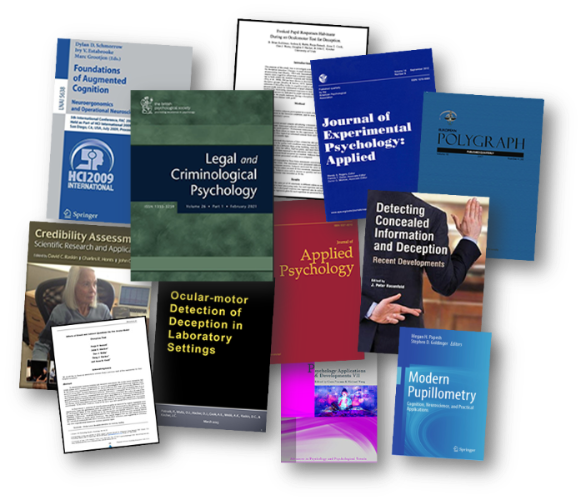
Trusted by the United States Dept. of Defense and 28 other global government agencies since 2015.

Scientific Validation & Peer-Reviewed Publication
Our industry-leading technology is supported by 23 peer-reviewed studies, making it the most scientifically validated credibility assessment tool available. This extensive research underscores EyeCanKnow's commitment to providing accurate, reliable, and non-invasive deception detection solutions.
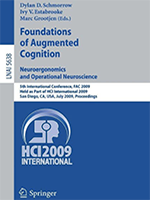
1) Webb, Hacker, Osher, Cook, Woltz, Kristjansson & Kircher (2009) Eye Movements and Pupil Size Reveal Deception in Computer Administered Questionnaires. In Schmorrow, Estabrooke, & Grootjen (Eds.), Foundations of Augmented Cognition. Neuroergonomics and Operational Neuroscience (553-562). Berlin/Heidelberg: Springer-Verlag.
Conclusions: (a) Pupil diameter and reading behaviors are diagnostic of deception and (b) Ocular-motor measures may supplement or be an alternative to the polygraph or self-report measures.
Read the full article
Conclusions: (a) Pupil diameter and reading behaviors are diagnostic of deception and (b) Ocular-motor measures may supplement or be an alternative to the polygraph or self-report measures.
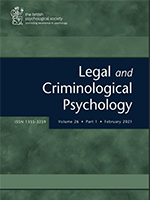
2) Webb, Honts, Kircher, Bernhardt & and Cook (2009) Effectiveness of Pupil Diameter in a Probable-Lie Comparison Question Test for Deception. Legal and Criminal Psychology, 14(2), 279-292. (Requires Subscription)
Conclusions: (a) Pupil diameter is a significant predictor variable for deception and (b) Pupil diameter may be a possible replacement for the traditional relative blood pressure measure.
Read the full article
Conclusions: (a) Pupil diameter is a significant predictor variable for deception and (b) Pupil diameter may be a possible replacement for the traditional relative blood pressure measure.
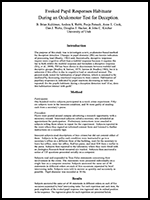
3) Kuhlman, Webb, Patnaik, Cook, Woltz, Hacker & Kircher (09/2011) Evoked Pupil Responses Habituate During an Oculomotor Test for Deception. Presented at the Society for Psychophysiological Research Convention, Boston. (abstract)
Conclusions: (a) Pupil reactions decrease in amplitude over repetitions of test questions (habituate) and (b) The diagnostic value of pupil reactions to different types of test items does not change over repetitions of test questions.
Read the full article
Conclusions: (a) Pupil reactions decrease in amplitude over repetitions of test questions (habituate) and (b) The diagnostic value of pupil reactions to different types of test items does not change over repetitions of test questions.
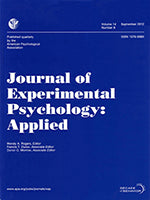
4) Cook, Hacker, Webb, Osher, Kristjansson, Woltz & Kircher (2012) Lyin’ Eyes: Ocular-motor Measures of Reading Reveal Deception. Journal of Experimental Psychology: Applied, 18(3), 301-313.
Conclusions: (a) Reading behaviors may be used to detect deception and may supplement or provide an alternative to the polygraph or self-report measures in some field settings and (b) Relevant Comparison Test (RCT) accuracy is 85%.
Read the full article
Conclusions: (a) Reading behaviors may be used to detect deception and may supplement or provide an alternative to the polygraph or self-report measures in some field settings and (b) Relevant Comparison Test (RCT) accuracy is 85%.
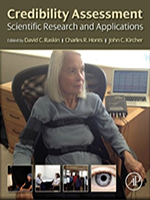
5) Hacker, Kuhlman, Kircher, Cook & Woltz (2014). Detecting Deception Using Ocular Metrics During Reading. In Raskin, Honts, & Kircher (Eds.), Credibility Assessment: Scientific Research and Applications. Elsevier, pp 159-216. (Requires Subscription)
Conclusions: (a) Ocular-motor tests for deception were 85% accurate in lab experiments and 78% accurate in a field study and (b) Ocular-motor tests were ineffective for participants with poor reading skills.
Read the full article
Conclusions: (a) Ocular-motor tests for deception were 85% accurate in lab experiments and 78% accurate in a field study and (b) Ocular-motor tests were ineffective for participants with poor reading skills.
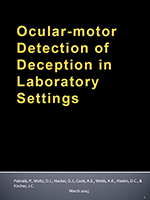
6) Patnaik, Woltz, Cook, Webb, Raskin & Kircher (March 2015) Ocular-motor Detection of Deception in Laboratory Settings. American Psychology & Law Society, San Diego, CA.
Conclusions: (a) Accuracy rates on cross-validation were about 80% for guilty and innocent groups in lab experiments using discriminant analysis and (b) Accuracy rates on cross-validation were about 84% for both groups using logistic regression analysis.
Read the full article
Conclusions: (a) Accuracy rates on cross-validation were about 80% for guilty and innocent groups in lab experiments using discriminant analysis and (b) Accuracy rates on cross-validation were about 84% for both groups using logistic regression analysis.
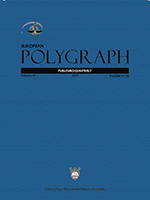
7) Kircher & Raskin (2016) Laboratory and Field Research on the Ocular-motor Deception Test. European Polygraph Journal, Volume 10, Number 4 (38).
Conclusions: (a) The Relevant Comparison Test (RCT) may contribute to pre-employment & periodic screening programs, particularly in government agencies concerned with law enforcement & national security; (b) Countermeasures are unlikely to affect outcomes; (c) Results generalize to US, Mexico, & Middle East populations and (d) Relevant Comparison Test accuracy is 86%.
Read the full article
Conclusions: (a) The Relevant Comparison Test (RCT) may contribute to pre-employment & periodic screening programs, particularly in government agencies concerned with law enforcement & national security; (b) Countermeasures are unlikely to affect outcomes; (c) Results generalize to US, Mexico, & Middle East populations and (d) Relevant Comparison Test accuracy is 86%.
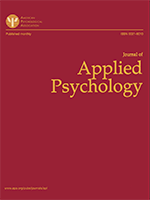
8) Patnaik, Woltz, Hacker, Cook, Francke-Ramm, Webb & Kircher (2016) Generalizability of an Ocular-Motor Test for Deception to a Mexican Population. International Journal of Applied Psychology, 6(1): 1-9.
Conclusions: (a) RCT accuracy was 86% in a large sample of students at a Mexican university and (b) Effects of deception on ocular-motor measures were similar in Mexican and U.S. populations.
Read the full article
Conclusions: (a) RCT accuracy was 86% in a large sample of students at a Mexican university and (b) Effects of deception on ocular-motor measures were similar in Mexican and U.S. populations.
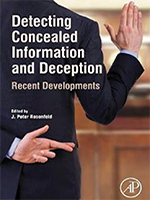
9) Kircher (2018) Ocular-motor Deception Test. In P. Rosenfeld (Ed.), Detecting Concealed Information and Deception (pp. 187–212), Elsevier Academic Press. (Subscription)
Conclusions: (a) Relevant Comparison Test accuracy ranges from 80-86% and (b) Effects on ocular-motor measures are similar in lab and field settings.
Read the full article
Conclusions: (a) Relevant Comparison Test accuracy ranges from 80-86% and (b) Effects on ocular-motor measures are similar in lab and field settings.
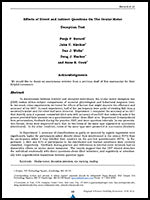
10) Bovard, Kircher, Woltz, Hacker & Cook (2019) Effects of direct and indirect questions on the ocular-motor deception test. Polygraph & Forensic Credibility Assessment, 48(1), 40-59.
Conclusions: (a) Accuracy using direct questions is more significant (83%) than using indirect questions (60%) and (b) Accuracy improves when direct questions are asked using unpredictable transitions between question types rather than in blocks.
Read the full article
Conclusions: (a) Accuracy using direct questions is more significant (83%) than using indirect questions (60%) and (b) Accuracy improves when direct questions are asked using unpredictable transitions between question types rather than in blocks.
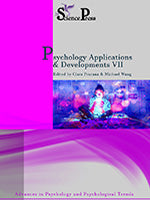
11) Handler & Nacházelová (2021) Hybrid Polygraph and Ocular-Motor Deception Tests for Screening and Specific-Incident Investigations. In Pracana & Wang (Eds.), Psychology Applications & Developments VII (pp. 80-92), inScience Press.
Conclusions: (a) Ocular-motor + polygraph testing yields 86 to 91% accuracy, (b) Ocular-motor deception test accuracy is between 85 and 87%, (c) Pulse transit time is diagnostic of deception and (d) Pupil reactions are more diagnostic of deception than traditional measures in automated polygraph examinations.
Read the full article
Conclusions: (a) Ocular-motor + polygraph testing yields 86 to 91% accuracy, (b) Ocular-motor deception test accuracy is between 85 and 87%, (c) Pulse transit time is diagnostic of deception and (d) Pupil reactions are more diagnostic of deception than traditional measures in automated polygraph examinations.

12) Cook, Potts, Kupcova, Hacker, Woltz, & Kircher (2024) Using Pupillometry in the Detection of Deception. In Goldsmith & Papesh (Eds.), Modern Pupillometry: Cognition, Neuroscience, and Practical Applications, Springer Press. (Requires subscription)
Conclusions: (a) Pupillary response remains one of the strongest indicators of deception, (b) When pupil diameter changes are combined with behavioral responses in the ODT, the result is a highly diagnostic tool that can be used in screening and criminal investigation scenarios, and with a wide range of participants, (c) Early research demonstrates ODT is relatively resistant to effects of countermeasures.
Read the full article
Conclusions: (a) Pupillary response remains one of the strongest indicators of deception, (b) When pupil diameter changes are combined with behavioral responses in the ODT, the result is a highly diagnostic tool that can be used in screening and criminal investigation scenarios, and with a wide range of participants, (c) Early research demonstrates ODT is relatively resistant to effects of countermeasures.
Product Specifications & Technical Overview
(VerifEye, EyeDetect, and EyeDetect+ )
View/Download the Technical PDF
TECHNICAL PRODUCT INFORMATION
Bayesian Decision-Making Mitigates Effects of Base Rates on Outcome Confidence: A Monte Carlo Simulation – APA Journal, March 2024 (Warner, Anderson, & Kircher)
PDF
How Connecticut State and Federal Probation Innovated Credibility Assessment Testing of Sex Offenders – Journal of Offender Monitoring, Vol. 34, No. 02, Fall/Winter, p. 9-10 (Thiel)
PDF
Considering Base Rates in Testing Populations – Warner (2018)
PDF
Estimating Base Rates of Deception – Warner (2024)
PDF
Benefits of Successful Hurdle Testing in Court Cases – Warner (2024)
PDF
Tactical Credibility Assessment Technology – Handler (2021)
PDF
Psychophysiological and ODT Detection of Deception– Kircher & Raskin (2014)
PDF
Low Base Rate Screening Survival Analysis & Successive Hurdles, The Police Polygraphist Journal, March 2016 (Handler)
PDF
